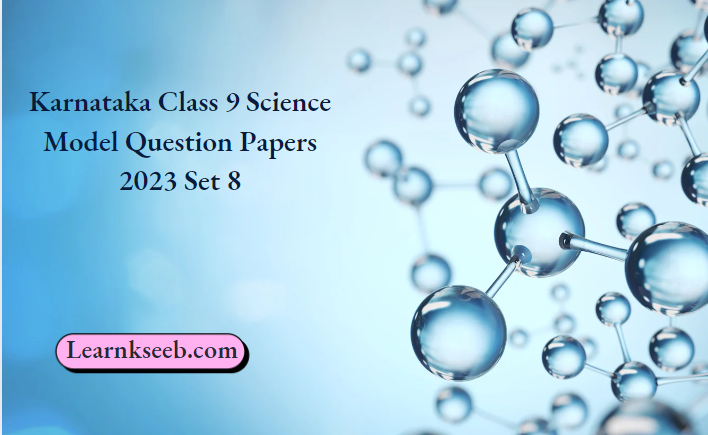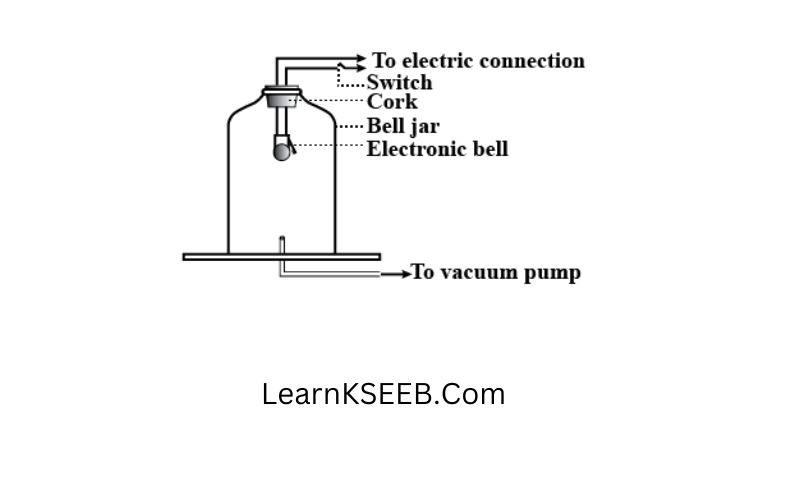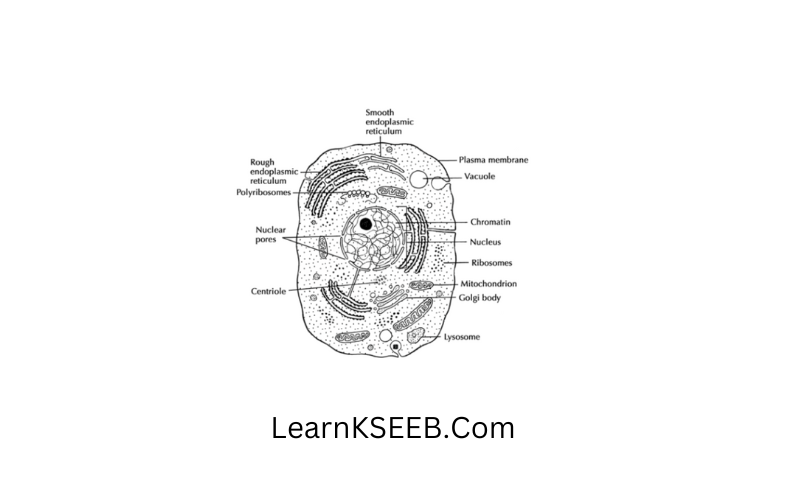Karnataka Class 9 Science Model Question Papers 2023 Set 8
Choose The Correct Alternative And Write The Complete Answer Along With Its Alphabet In Sheet Provided:
Question 1.The temperature at which solids melt
- Boiling point
- Melting point
- Both (1) and (2)
- Water point
Answer: 2. Melting point
Question 2. Which of the following is not a colloidal solution?
- Sugar solution
- Blood
- Milk
- Toothpaste
Answer: 4. Toothpaste
Karnataka 9th Standard Science Model Paper 2023 Set 8 Free PDF with Answer Key
Question 3. The symbol of Glod is
- Go
- Ga
- Gd
- Au
Answer: 4. Au

Question 4. An element has electronic configuration 2, 6; the element is
- Carbon
- Nitrogen
- Oxygen
- Fluorine
Answer: 3. Oxygen
Question 5. Which of the following is used in radiocarbon dating?
- \({ }_6 \mathrm{C}^{12}\)
- \({ }_6 \mathrm{C}^{12}\)
- \({ }_6 \mathrm{C}^{14}\)
- \({ }_6 \mathrm{C}^{11}\)
Answer: 3. \({ }_6 \mathrm{C}^{14}\)
Question 6.The physical quantity which is not a vector
- Displacement
- Distance
- Acceleration
- Force
Answer: 2. Distance
Question 7. Rocket works on the principle of conservation of
- Mass
- Energy
- Momentum
- Velocity
Answer: 3. Momentum
Question 8. S.I. unit of G is
- N – kg2/m2
- N – M / kg2
- N – m2/ kg2
- N – m2/ kg
Answer: 3. N – m2/ kg2
Question 9. Compressed spring has
- Kinetic energy
- Heat energy
- Potential energy
- Light energy
Answer: 3. Potential energy
Question 10. A sound wave cannot propagate in
- Air
- water
- vacuum
- Metals
Answer: 3. Vacuum
Match The Following:
A B
Rutherford stationary orbits
J.J. Thomson nucleus
James Chadwick Neutron
Goldstein proton
electron
Answer:
A B
Rutherford nucleus
J.J. Thomson electron
James Chadwick Neutron
Goldstein proton
Answer The Following:
Question 1. Who discovered cells and how?
Answer: Robert Hook discovered cells. He observed the cells in a slice of cork with the help of a primitive microscope.
Question 2. What are the functions of the endoplasmic reticulum?
Answer:
- It functions as a passageway for intracellular transport.
- It functions as a manufacturing surface.
Question 3. Give any two illustrations for Newton’s third law of motion.
Answer:
- when a bullet is fired from a gun, the gun recoils with an equal force in the opposite direction,
- swimmer while swimming pushes the water backward and in turn, he moves forward.
Question 4. How many types of elements together make up the xylem tissue? Name them.
Answer:
xylem tissue is made up of:
- Xylem parenchyma
- xylem Fibres
- xylem tracheids
- xylem vessels or tracheids
Class 9 Karnataka Science Model Paper 2023 Set 8 Solved Questions PDF
Question 5. What is the role of the epidermis in plants?
Answer:
Role of the epidermis in plants:
- It protects the internal parts of the plant’s body. Plant organs from external injury, temperature, micro-organisms, parasitic fungi, etc.,
- It protects the plant from excessive loss of water. from internal tissues.
Question 6. How do gymnosperms and angiosperms different from each other?
Answer:
Gymnosperms:
- Non-flowering plants
- Plants bear naked seeds
- They are perennial, evergreen woody
Angiosperms:
- Flowering plants
- Seeds are covered by fruit
- They are annual, biennial, perennial, woody, or nonwoody.
Question 7. What management practices are common in dairy and poultry farming?
Answer:
- Management practices are common in dairy and poultry farming.
- Feeding of animals
- Providing shelter for an animal
- Animal health and care
- Breeding of animals
Question 8. Why do we classify organisms?
Answer:
We classify organisms into groups and subgroups because:
- There are a million types of (living) organisms.
- It is difficult to study all of them.
- It helps us to know about the organisms and groups of organisms of the same characteristics in groups and organisms of different characteristics
Question 9. Give the characteristics of poriferan animals.
Answer:
- They have small pores called Ostia and a large
aperture called the osculum. Hence they are called pore bearers (Porifera) - They have a canal system for the passage of water currents.
- The body cavity is called spongocoel
- Body organization is cellular and does not have tissues For Example sycon
Question 10. Why do organisms need water?
Answer:
Organisms need water because:
- It is an important medium in which all the metabolic reactions and life processes take place in the cells and the body.
- It is a universal solvent. It dissolves many substances within the cells for reaction to take place
- Terrestrial organisms require fresh water for getting rid of high amounts of dissolved salts from the body.
- It helps in the transportation of materials in the body.
Question 11. A substance has a fixed volume but no fixed shape. In which physical state does it exist? Give an example for that state.
Answer: Liquid
Example: water, oil
Question 12. Give any two uses of radioisotopes.
Answer:
- Isotope of cobalt is used in the treatment of cancer
- Isotope of Iodine is used in the treatment of goiter
Question 13. What is the importance of the universal law of gravitation?
Answer:
- The force that binds us to the earth.
- The motion of the moon around the earth.
- The motion of planets around the sun.
- The tides due to the moon and the sun
Question 14.Calculate the molecular mass of ammonia (NH3) (Given atomic mass of H = 1, N = 14)
Answer:
Molecular mass of ammonia =N x 1 + H x 3
= 14 x 1 + 1 x 3
= 14 + 3
= 17u
Karnataka Board 9th Science Model Paper 2023 Set 8 Latest Exam Pattern PDF
Question 15.Define
- Frequency
- Amplitude.
Answer:
- Frequency: The number of complete oscillations per unit of time is called frequency.
- Amplitude: The magnitude of the maximum disturbance in the medium on either side of the mean value is called Amplitude.
Question 16. What will be the acceleration of a body of mass 5kg if a force of 200N is applied to it?
Answer:
F = 200NM = 5kg
F = ma
a = ?
\(a=\frac{F}{M}=\frac{200^{40}}{\beta_1}\)
a = 40ms-2
Question 17. Differentiate between potential energy and kinetic energy.
Answer:
Potential energy:
- The energy possessed by a body due to its change in position or shape
- PE = mgh
Example: stretched rubberband
Kinetic energy:
- The energy possessed by a body by virtue of its motion
- KE = \(\frac{1}{2}\) mv2
Example: moving vehicle
Question 18. Compressed natural gas is used as fuel these days in vehicles. Why?
Answer: Due to its high compressibility large volumes of gas can be compressed into a small cylinder and transported easily.
Question 19. List the properties of a colloid.
Answer:
- It is a heterogeneous mixture
- The size of the particles is too small to be individually seen by the naked eye.
- They scatter the beam of light passing through it
- They do not settle down when left undisturbed
- They cannot be separated from the moisture by the process of filtration
Question 20. Distinguish between distance traveled and displacement.
Answer:
Distance traveled:
- It is a scalar quantity
- It is the actual path taken by an object
Displacement:
- It is a vector quantity
- It is the shortest distance from the initial position.
Question 21. A racing car has a uniform acceleration of 4ms1. What distance will it cover in 10s after the start?
Answer:
a = 4ms-2
u = 0 t= 10s s = ?
s = ut + \(\frac{1}{2}\) a + 2
\(=0 \times 10+\frac{1}{2} \times 4 \times(10)^2\) \(=\frac{1}{\not 2} \times 4^2 \times 100\)∴ S= 200
Question 22. Mention the difference between balanced and unbalanced forces.
Answer:
- Balanced Forces: Forces that do not change the state of motion of a body are called balanced forces
- Unbalanced Forces: Forces that cause a change in the state of motion of a body are known as unbalanced
Question 23. What is penicillin? Give its function.
Answer: Penicillin is a drug that does not allow bacteria to build a protective wall thus it dies off easily. It is used to cure diseases and infections caused by bacteria.
Class 9 Karnataka Science Model Papers Set 8 PDF
Question 24. Name the diseases each caused by bacteria, viruses, fungi, and protozoa
Answer:
- Bacteria: Typhoid, Cholera
- Virus: Dengue fever, AIDS
- Fungi: Ringworm, Jock itch
- Protoza: Malaria, Kala-azar
Answer The Following :
Question 1. Differentiate between mass and weight.
Answer:
Mass:
- It is a scalar quantity
- It remains constant everywhere
- Its SI unit is kg
- It can never be zero.
- Mass is the content of matter in a body
Weight:
- It is a vector quantity
- It changes as gravity changes
- Its SI unit is newton
- At the center of the earth weight of a body is zero.
- Weight is the force by which the earth attracts it.
Question 2. State the three of Newton’s laws of motion.
Answer:
- The first law of motion: An object continues to be in a state of rest or of uniform motion along a straight line unless acted upon by an unbalanced force.
- The second law of motion: The rate of change of momentum of an object is proportional to the applied unbalanced force in the direction of the force.
- Third law of motion: To every action, there is an equal and opposite reaction and they act on two different bodies.
Question 3. Define the following
- Melting point
- Boiling point
- Latent heat of fusion
Answer:
- Melting point: The temperature at which solid melts to become a liquid at the atmospheric pressure is called its melting point.
- Boiling point: The temperature at which a liquid starts boiling at the atmospheric pressure is known as its boiling point.
- Latent heat of fusion: The amount of heat energy that is required to change 1kg of a solid into liquid at atmospheric pressure at its melting point is known as the latent heat of fusion.
Karnataka 9th Science Sample Paper 2023 Set 8 for Board Exam Preparation
Question 4. Differentiate between animals belonging to the Aves group and those in the Mammalia group.
Answer:
Aves:
- The body is covered by feathers
- The body is streamlined that is boat-shaped
- Forelimbs are modified into wings for flight
- The mouth is modified into beaks.
Example: Sparrow, Pigeon
Mammalia:
- The body is covered by hair
- The body is divisible into a head, neck, trunk, and tail
- The animal has 2 pairs of limbs for walking and 2 limbs for doing work
- The mouth has teeth for chewing food.
Example: Man, cow
Answer The Following:
Question 1. A ball is thrown up vertically and returns to the thrower after 6 sec find.
- The velocity with which it was thrown up
- The maximum height it reaches and
- Its position after 4s
Answer:
total time of flight = 6s
so the time to go up = \(\frac{6}{2}\) = 3
- v = u -gt
0 = u- 10 x 3
∴ u = 30ms-1 - v2-u2– 2gh
0 =(30)2– 2 X 10 X h
0 = 900 – 20h
h= \(\frac{900}{20}\) = 45m - h= ut – \(\frac{1}{2}\) gt2\(=30 \times 4-\frac{1}{\not 2} \times 10^5 \times(4)^2\)
= 120 – 5 x 16
= 120 – 80
∴ h=40m
Question 2. Draw a diagram to show that sound needs a material medium for its propagation
Answer:

Question 3.
- State two characteristic features of Amphibians
- Identify the following organisms.
- organisms that have an open circulatory system with blood filled coelomic cavity.
Answer:
- They are cold-blooded animals. They have a three-chambered heart
- Amphibians, Echinoderms, Arthropods.
Karnataka State Board Class 9 Science Model Paper 2023 Set 8 with Step-by-Step Solutions
Question 4. State the differences between solid, liquid & gas.
Answer:
solid:
- Have strong intermolecular force]
- Very less intermolecular space
- Have definite shapes, mass & volume
- Have high density
- Cannot be compressed
Liquid:
- Weak intermolecular force
- Large intermolecular space
- Do not have shape but have volume
- Density is low
- Can be compressed
Gas:
- Very weak intermolecular force
- Very large intermolecular space
- No definite shape & volume
- Very low density
- Highly compressed
Answer The Following:
Question 1. How can you separate the following mixtures
- Sand and Iron
- Copper sulfate and water
- Gases from air
- Acetone from water
Answer:
- Magnetic separation
- crystallization
- Fractional distillation
- Distillation
9th Standard Karnataka Science Sample Paper 2023 Set 8 Important Questions PDF
Question 2. Write the conclusions drawn by Rutherford when the observed the following. Most of the alpha particles pass straight through the gold foil
Answer:
- There is a lot of empty space inside an atom.
- The center of the atom which is the nucleus is positively charged.
- The nucleus is extremely hard and dense.
Question 3. For the same kinetic energy of a body, what should be the change in its velocity if its mass is increased sixteen times?
Answer:
Let initial mass M1= m, velocity V1= V
Final mass M2= 16m, velocity V2 =?
& \frac{1}{2} m_1 v_1^2=\frac{1}{2} m_2 v_2^2 \\
& \frac{1}{2} m v^2=\frac{1}{2} \times 16 m \times v_2^2 \\
& v_2^2=\frac{v^2}{16} \\
& v_2=\sqrt{\frac{v^2}{16}} \\
& =\frac{v}{4}
\end{aligned}\)
∴ \(v_2=\frac{1}{4} v \)
Thus velocity should be one fourth
Question 4. Draw a neatly labeled diagram of an animal cell.
Answer:

